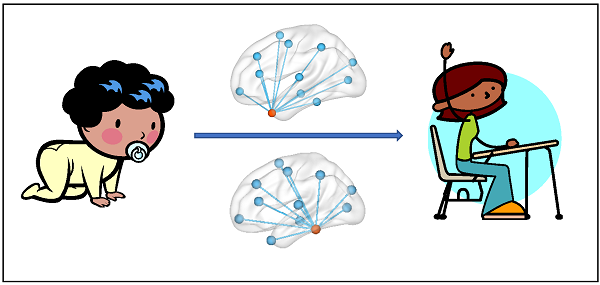By Xi Yu and Nadine Gaab
Babies start language acquisition in the womb. Once born, neonates already show selective neural responses to human speech and can recognize different aspects of speech, such as phonetic and stress patterns. However, babies’ brains are not set in stone. When children actively interact with their linguistic environment, dramatic changes occur in the developing brain. To what extent infant brain characteristics are associated with individual differences in language skills at school age remains a fundamental question, bearing significant theoretical and practical implications.
Utilizing infant imaging techniques combined with a longitudinal design, the Gaab lab has collected brain images from over 100 infants, and subsequently followed the language development of (most) of these children into school age. Based on this dataset, we are the first to reveal that the functional connectivity patterns established within the first 18 months are predictive of the subsequent language skills at 6.5 years old. We studied functional connectivity because it is an ideal tool to probe the intrinsic functional organization of a developing brain. Human brains exhibit spontaneous neural activities that form functional networks with coherent neural fluctuations, supporting various basic- and high-level capacities such as visual processing and executive functioning. Resting-state functional connectivity characterizes the correlates of spontaneous neural fluctuations when individuals are not involved in any task.

Functional connectivity patterns of left temporal pole (upper) and left fusiform gyrus (bottom) in infancy predict language skills in school age
Our results show that, even in infants, different neural regions already exhibit variable functional connectivity characteristics. And distinctive functional network patterns are uniquely and specifically linked to different aspects of language abilities, such as oral language and phonological processing skills, measured at school age. These longitudinal links are observed independently of key environmental characteristics in infancy. Moreover, the emergent language skills in infancy significantly contributed to the observed associations, implicating a role of early linguistic experiences in shaping the brain function for long-term language development. Our findings highlight the importance of functional organization established in infancy and toddler-hood as a neural scaffold underlying the learning process of complex cognitive functions, holding important implications for early childhood educational and caregiver practices.
Xi Yu is an assistant professor at Beijing Normal University, and was previously a postdoctoral fellow in the Gaab Lab.
Nadine Gaab is an associate professor at Harvard Graduate School of Education.
Learn more in original research article:
Functional Connectivity in Infancy and Toddlerhood Predicts Long-Term Language and Preliteracy Outcomes.
Yu X, Ferradal SL, Sliva DD, Dunstan J, Carruthers C, Sanfilippo J, Zuk J, Zöllei L, Boyd E, Gagoski B, Ou Y, Grant PE, Gaab N. Cereb Cortex. 2021 Aug 4.
News Types: Community Stories
